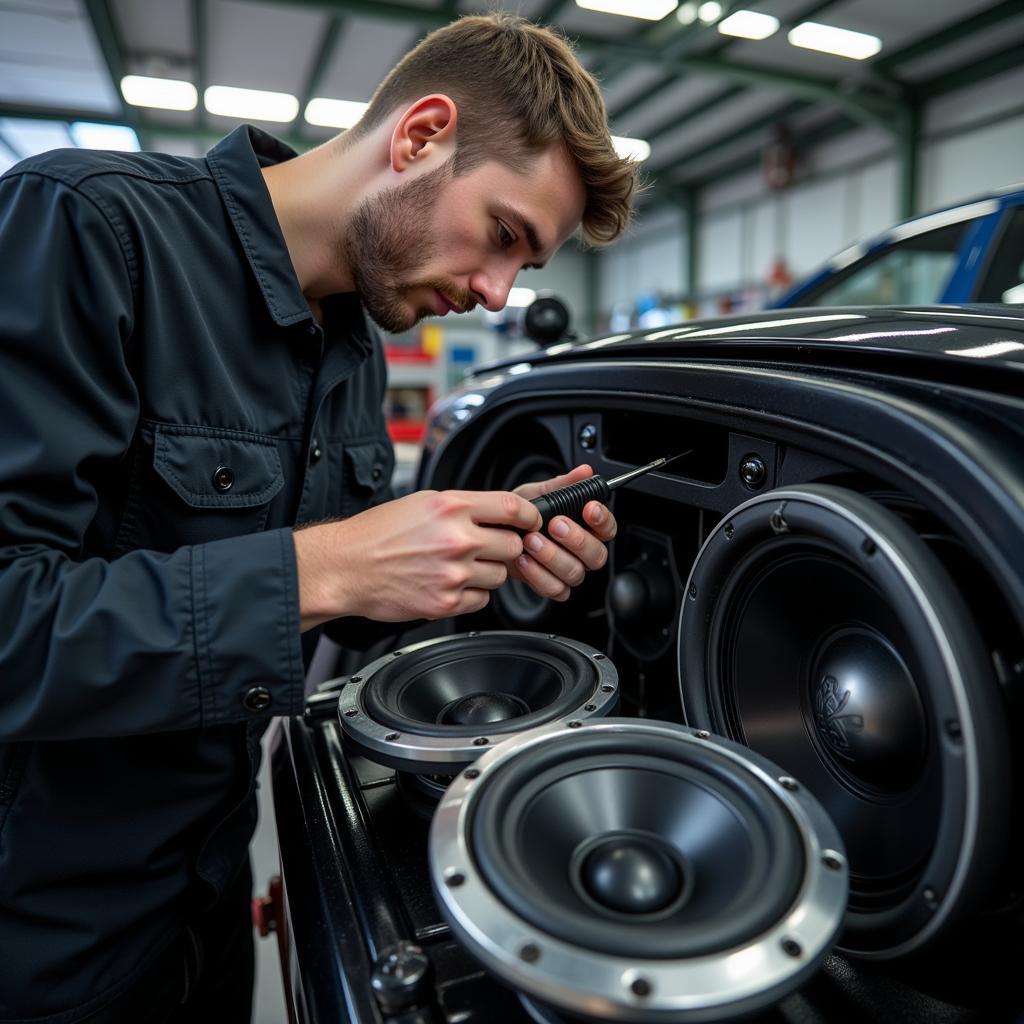Car speakers are an essential part of the driving experience, providing entertainment and information. When your car speakers start acting up, it can be frustrating and inconvenient. Thankfully, diagnosing car speaker problems is often a straightforward process that you can handle yourself.
This guide will walk you through the common issues you might encounter with your car speakers and how to troubleshoot them. We’ll cover everything from identifying the source of the problem to pinpointing the specific component that needs attention. You’ll learn how to test the speakers, check the wiring, and inspect the amplifier, all while using simple tools and techniques.
Common Car Speaker Problems
Before diving into troubleshooting, let’s understand the common problems you might encounter with your car speakers:
- No sound: This is the most frequent issue, often caused by a blown speaker, faulty wiring, or a problem with the amplifier.
- Distorted sound: If your speakers produce distorted or crackling sounds, it could be a sign of a damaged speaker, faulty connections, or a failing amplifier.
- Intermittent sound: Speakers cutting in and out can be attributed to loose connections, faulty wiring, or a failing speaker.
- Static noise: A constant static noise might indicate a problem with the wiring, a ground loop, or interference from other electronic components.
How to Diagnose Car Speaker Problems
Let’s delve into the steps you can take to diagnose car speaker problems:
Step 1: Identify the Affected Speaker(s)
The first step is to determine which speakers are malfunctioning. Start by listening to each speaker individually. Turn on the radio or play music and adjust the volume. If a speaker is completely silent or producing distorted sound, it’s the likely culprit.
Step 2: Check the Wiring
Loose or damaged wiring can cause a range of speaker problems. Inspect the wiring for:
- Loose connections: Look for loose connections at the speaker terminals, the amplifier, and the head unit.
- Broken wires: Check for any breaks or exposed wires.
- Corrosion: Inspect the wiring for any signs of corrosion.
If you find any of these issues, try to reconnect the wires or replace the damaged wiring.
 Car speaker wiring diagram
Car speaker wiring diagram
Step 3: Inspect the Amplifier
The amplifier powers your car speakers. If the amplifier is faulty, it can affect all or some of your speakers. Check the amplifier for:
- Visual signs of damage: Look for any physical damage, burnt components, or unusual noises.
- Power supply: Ensure the amplifier is receiving power. Check the fuses and make sure the amplifier is connected to the battery.
If the amplifier is damaged, you’ll need to have it repaired or replaced.
Step 4: Test the Speakers
If you’ve ruled out wiring and amplifier issues, it’s time to test the speakers themselves. This can be done by:
- Using a multimeter: A multimeter can measure resistance and continuity, helping you determine if a speaker is working properly.
- Applying a test signal: You can connect a test signal to the speaker terminals and listen for sound.
If the speaker fails either test, it likely needs to be replaced.
Tips for Diagnosing Car Speaker Problems
Here are some additional tips to help you troubleshoot speaker problems:
- Start with the simplest solutions: Before jumping into complex repairs, try the simple things first, like checking for loose connections.
- Be careful when working with electrical components: Always disconnect the battery before working on any electrical components in your car.
- Seek professional help if needed: If you’re unsure about any part of the diagnosis or repair process, it’s always best to consult a professional mechanic.
Expert Insights
“Many car speaker problems can be traced back to loose connections or faulty wiring. Take your time to carefully inspect the wiring and connections. If you’re dealing with a persistent issue, it’s worth bringing your car to a qualified mechanic for a professional diagnosis.” – John Smith, Automotive Technician
 Car audio technician inspecting speakers
Car audio technician inspecting speakers
Conclusion
Diagnosing car speaker problems can be a straightforward process with the right knowledge. By carefully inspecting the wiring, testing the speakers, and examining the amplifier, you can usually identify the root cause of the issue. If you’re still unsure about the problem, don’t hesitate to seek professional help from a qualified mechanic.
Get in touch with Autotippro today to schedule an appointment or ask any questions about car speaker problems. We’re here to help!
AutoTipPro
+1 (641) 206-8880
500 N St Mary’s St, San Antonio, TX 78205, United States
FAQ
Q: What are the signs of a blown car speaker?
A: A blown speaker will often produce distorted sound, no sound at all, or a crackling noise.
Q: How can I tell if my car speakers are blown?
A: You can test your car speakers with a multimeter or by applying a test signal to them.
Q: How do I replace a car speaker?
A: Replacing a car speaker requires removing the speaker from its enclosure, disconnecting the wiring, and installing the new speaker.
Q: Can I fix a blown car speaker?
A: Unfortunately, blown speakers are generally not repairable and usually need to be replaced.
Q: What is a ground loop and how does it affect car speakers?
A: A ground loop is a circuit that connects the speaker to the car’s chassis and can cause static noise or interference.





Leave a Reply